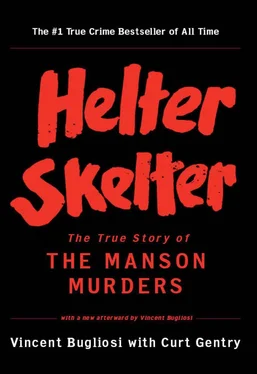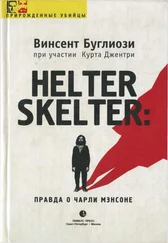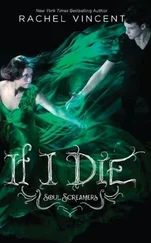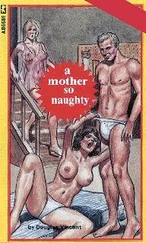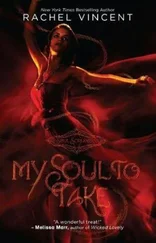Afterword © 1994 by Vincent Bugliosi
All rights reserved.
LIBRARY OF CONGRESS CATALOGING-IN-PUBLICATION DATA
Bugliosi, Vincent.
Helter skelter: the true story of the Manson murders / Vincent Bugliosi, with Curt Gentry.—/with a new afterword by Vincent Bugliosi.
p. cm.
Simultaneously published in Canada.
1. Murder—California—Case studies. 2. Manson, Charles, 1934–.
I. Gentry, Curt, 1931–. II. Title.
HV6533.C2B83 1994
364.'523'0979493—dc20
94-20957
ISBN: 978-0-393-07236-5
W. W. Norton & Company, Inc.
500 Fifth Avenue, New York, N.Y. 10110
www.wwnorton.com
W. W. Norton & Company Ltd.
Castle House, 75/76 Wells Street, London W1T 3QT
The confusion extends to the arrival times of the units. Officer DeRosa would later testify he arrived about 9:05 A.M., which was before he supposedly received the Code 2. Officer Whisenhunt, who came next, set the time of his arrival at between 9:15 and 9:25, while officer Burbridge, who arrived after both men, testified he was there at 8:40.
Why he failed to identify the youth, whom he did know, is unknown. A good guess would be that Garretson was in shock. Also, adding to his confusion, it was about this time that, in looking toward the gate, he saw Winifred Chapman, whom he presumed dead, alive and talking to a police officer.
Since Granado, who arrived after DeRosa, Whisenhunt, and Burbridge, also saw them near the entryway, it would appear that the original officers weren’t responsible.
Apparently overlooked by LAPD, this was discovered by Roman Polanski when he visited the residence on August 17.
One writer would later claim that the police found a vast collection of pornography in the residence, including numerous films and still shots of famous Hollywood stars engaged in various sexual acts. Aside from the above, and several unexposed rolls of videotape, the only photographs found anywhere on the property were a set of wedding pictures and a large number of publicity shots of Sharon Tate.
The same writer also claimed that a number of black hoods were found in the loft. Apparently he created them out of the same material as his photos, for nothing even resembling a hood was found.
LAPD learned of him from Sharon’s parents. They also learned, from one of Sebring’s ex–girl friends, that he had had an argument with the hair stylist a few nights before the murder, in one of the Hollywood discothèques. After checking the man’s alibi, they cleared him of any possible involvement in the murders. The argument itself was minor: he had interrupted Sebring while he was trying to pick up a girl.
In 1972 a Los Angeles Superior Court judge broke with precedent and permitted the results of a polygraph test to be received into evidence in a marijuana case.
It was possible when Parent asked the time he also set the radio clock.
Since no one tried the door before using the key, it is unknown whether it was locked.
Some of the details were garbled. It was reported, from example, that the pillowcases were white hoods; that the phrase DEATH TO PIGS had been printed in blood on the refrigerator door, when it actually appeared on the wall in the living room. But enough information had leaked out for the detectives again to have trouble finding polygraph keys.
Everything in this book is based on fact. In a few instances the names of persons only tangentially involved have been changed for legal reasons, the cross symbol (+) indicating the substitution of a pseudonym for the true name. The persons were and are real, however, and the incidents depicted are entirely factual.
This would be actress Joanna Pettet’s second close brush with violent death. She had also been a friend of Janice Wylie, who, together with her roommate Emily Hoffert, had been murdered in New York City in the summer of 1963, in what became known as the “career girls murder case.”
LAPD eventually located the girl and determined that she had not accompanied Sebring to the Tate residence that night.
When Officer Whisenhunt searched the guest house following Garretson’s arrest, he noticed the volume control on the set was between 4 and 5.
Police shorthand for “also known as”; “t/n” means “true name.”
She was referring to Mary Brunner, first member of the Family, who had had a child by Manson. At this time the police were unaware of her involvement in the Hinman homicide.
The Atkins-Graham-Howard conversations have been taken from LAPD’s taped interviews with Virginia Graham and Ronnie Howard; my interviews with both; their trial testimony; and my interview with Susan Atkins. There are, of course, minor variations in wording. Major discrepancies will be noted.
Virginia Graham had seen the owner of the house, Rudi Altobelli, interviewed on TV, and although she couldn’t remember his name, she knew it wasn’t Terry Melcher. This was one reason why, initially, she was inclined to disbelieve Susan Atkins’ story. Susan, however, insisted Melcher was the owner, apparently believing he was.
Since neither the deputy nor her lieutenant was available for interviews, therefore making it impossible to present their version of these incidents, pseudonyms have been used for both.
Manson told DeCarlo that because he, Manson, was less amply endowed, he needed DeCarlo to keep the girls from running away. This sounds like a Manson con, though DeCarlo maintains it was true.
Since the Hinman residence in Malibu and Spahn’s Movie Ranch in Chatsworth were in the same dialing area, this was not a toll call; therefore the telephone company kept no record of it.
Beausoleil, Brunner, and Atkins went to Hinman’s residence on Friday, July 25, 1969. Manson slashed Hinman’s ear sometime late that night. Hinman was not killed, however, until Sunday, July 27, and it was not until the following Thursday, July 31, that his body was discovered by LASO, following a report from a friend who had been trying to reach Hinman for several days.
Ironically, on July 28, two LASO deputies—Olmstead and Grap—visited Spahn Ranch on another matter. While there they saw the Fiat, ran a spot check on the license, and learned that it belonged to Gary Hinman. Grap knew Hinman; he also knew he was a friend of the people at Spahn Ranch, and therefore didn’t feel there was anything suspicious about the station wagon’s being there. At this time, although Hinman was dead, his body had not yet been discovered.
After the discovery of the body on July 31, LASO put out a “want” on Hinman’s vehicles. Grap didn’t learn of it, or Hinman’s death, until much later. If he had known, of course, he could have directed the investigation to Spahn Ranch and the Manson Family months before Kitty Lutesinger implicated Atkins and the others.
The exact date of Shea’s death still remains unknown. It is believed to have occurred on either the night of Monday, August 25, or Tuesday, August 26, 1969.
Читать дальше
